I’m about to attempt the impossible; not only am I going to boil seven years of motorhoming experience and knowledge into this one article but I’m also going to try and infect you with my love for motorhome touring in France. Hold on tight, it’s going to be a whistlestop tour!
Why motorhoming?
Let me briefly tell you about how we set off on our first trip; a sabbatical travelling through France with a motorhome. It was back in 2012 when our kids were tiny. We’d planned on hiring a motorhome but had bought one instead, shocked at the price of rental in August and planning to resell it after the five-week road trip.
The resell didn’t happen and we spent seven long summers on the open road in that van before we finally sold it earlier this year (cue me weeping in the kitchen while my husband swapped cash with its new owner). We’re in the market for another one, we just need one that fits the clean-air-zone rules that are coming into play these days.
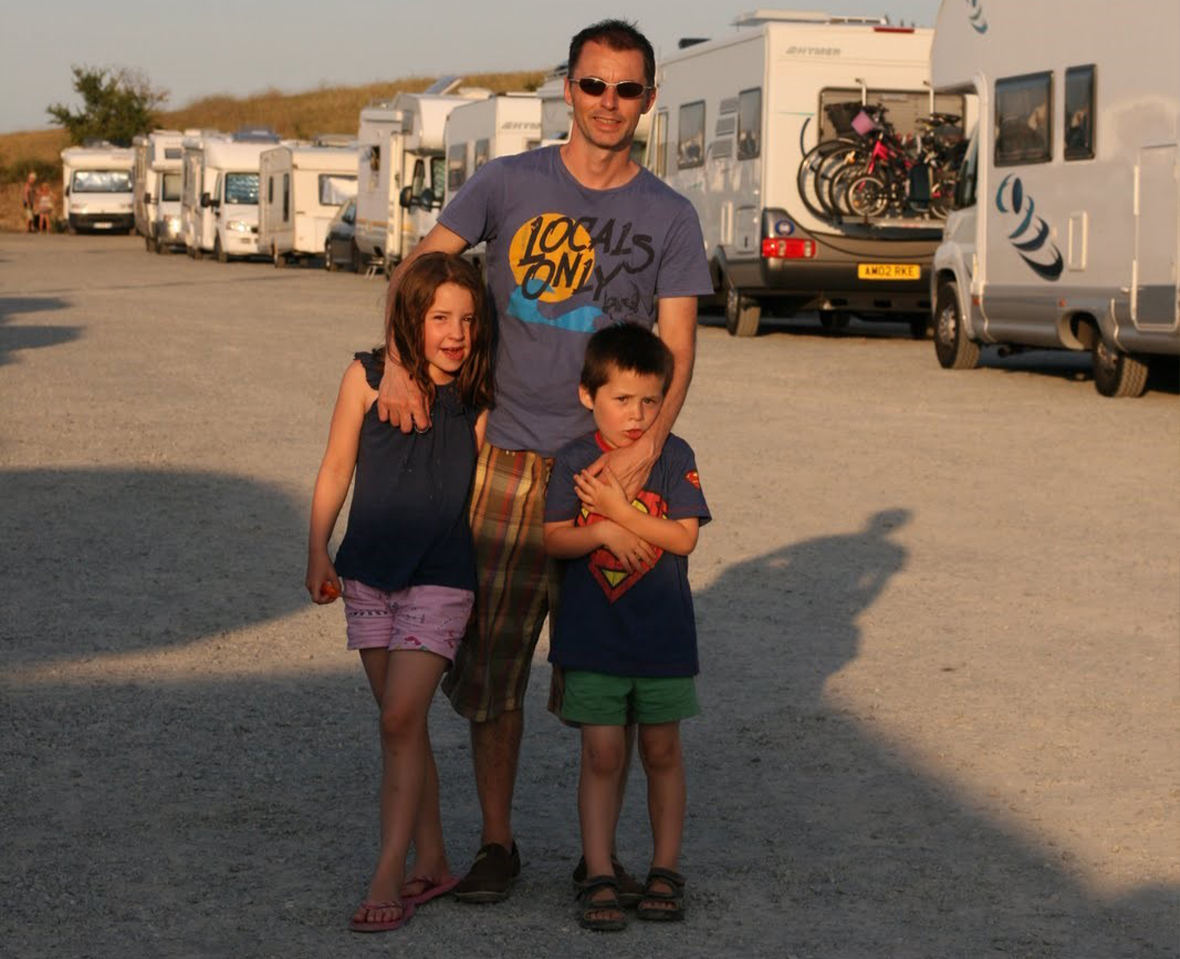
Our first trip in the van – in 2012 – where we toured the Atlantic coast, the Pyrenees and more
It was, and is, as they say in France, une grande passion; here are the benefits of a motorhome holiday as I see them:
- The nomadic life takes some getting used to but it’s liberating. We love living day to day and only planning the next twist of the road when it came into view.
- You’re a snail, your house is on your back. You can go anywhere and do anything. Throw open the picnic table, whip out your gingham tablecloth and whip up a five-course meal on a cliff edge to watch the sun set.
- Vans aren’t cheap to buy or rent but once you have them, you can take longer breaks for less cash.
- It‘s about the journey, not the destination. See parts of France that are off the beaten track. You end up exploring places you would never have found, places that you wouldn’t go to on a single-destination holiday but that are so charming and French.
- Motorhome aires in France are so well located – we’ve stayed in inner cities, within castle walls, at the bottom of ski pistes and steps away from a lake’s shore.
- The pace of life is simple and unhurried.
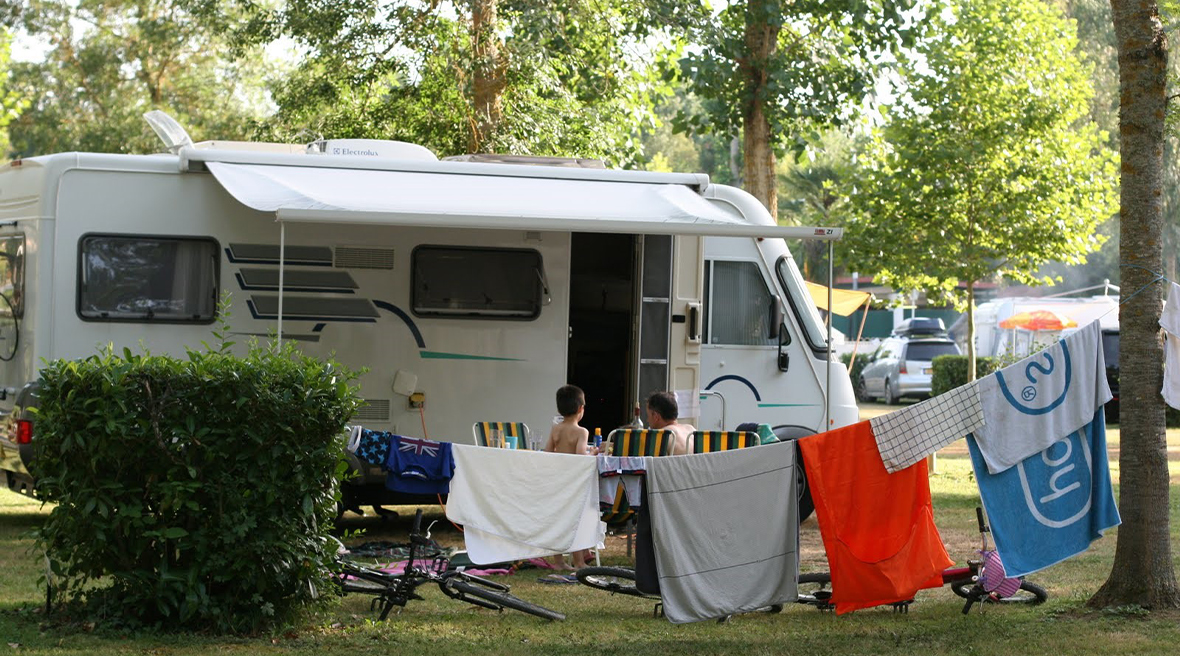
Here’s a classic setup on a campsite: shaded by trees, bikes strewn, card games underway!
But let’s get down to practicalities. What kind of vans are out there and what are the differences?
Difference between vans and motorhomes in terms of facilities
The fundamental difference between a camper van and a motorhome is the facilities. It’s a motor-HOME, so you’re looking at a fridge (possibly with a freezer) and cooker, water tanks, a sink, table and chairs, mains voltage electricity, a bedroom area, lots of storage space and of course, a toilet and bathroom with a shower. With all these comforts of home, you can go anywhere and stay anywhere.
Of course, if you want to travel in a campervan around France (as opposed to a motorhome) that’s perfectly possible too, but a lack of built-in washing and toilet facilities means you’ll probably need to spend more time in campsites.
Types of motorhomes
While some people count camper vans as types of motorhomes because you can always add an outside shower and portable toilet into the mix, I’m going to focus on the more luxurious side of things. You’ll see quite a few different shapes, sizes and types of motorhomes on the road in the UK and Europe, from a cute easy-to-drive two-person model all the way up to something that looks more like a bus.
Large van conversions
These are standard large vans, like a Ford Transit for example, which have been transformed into motorhomes. From the outside, they look like normal vans but with more windows and often with an awning attached to the side, waiting to be rolled out as a sunshade in sunny climes. They have everything you’d expect from a motorhome but squeezed into the smallest space possible.
Coachbuilt motorhomes
Coachbuilt models start with a cab and chassis from a van manufacturer, with the motorhome body built on top of it. You can spot these by the overhang above the cab – sometimes big enough to sleep in – these are the most common types of motorhomes. Often there’s a bed across the back, with a big storage area called the ‘garage’ beneath which is accessible from the outside.
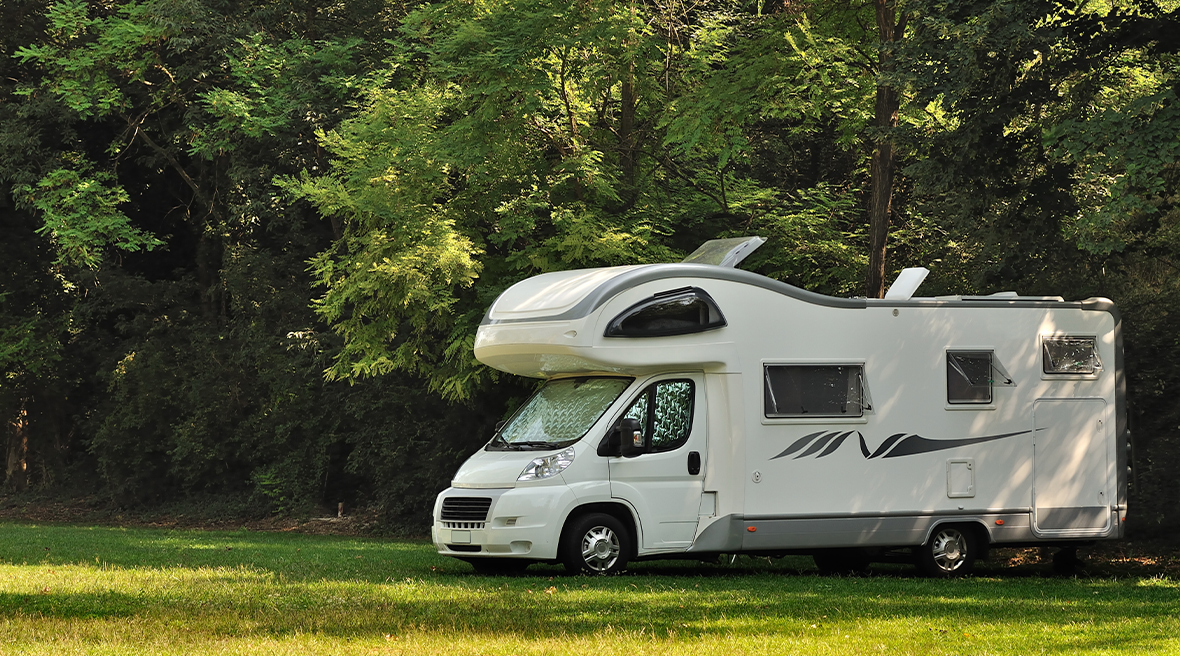
A classic coachbuilt motorhome – see the sleeping compartment set above the driver’s cab
‘A’ class motorhomes
These models, including the driving compartment, are built from scratch on a bare chassis so that there’s no separate cab. This gives the manufacturer freedom to use all the space available and add things like swivel front chairs, so you can sit and face a table inside, or a pulldown bed over the driving area. Some ‘A’ class motorhomes can be so large that need a tag axle, which is a third wheel on each side to support the weight.
Rules and regulations when driving a motorhome in France
A motorhome trip in France is a lot easier than in the UK. It’s generally less busy and there are a lot more motorhomes on the roads, which means that people are used to them and more accepting.
The rules and regulations are broadly the same as when you’re driving a car. Make sure you’ve got your passport, driving licence, V5 ownership papers and insurance documents. Fluorescent tabards and warning triangles are a must in case you break down. If you’ve not driven in France before, check out what you need on the AA or RAC websites.
Motorhome-specific things to look out for are height and weight restrictions – we wrote down our details on a piece of paper and stuck it to the dashboard so that we’d always be able to check when we saw a warning sign.
Speed limits are important. Built-up areas are 30km/h, while outside these it’s 80 or 90km/h depending on the type of road. Dual carriageways are 110km/h while motorways are 130km/h. However, if you’ve held your licence for less than 3 years or it’s raining or the visibility is reduced, it’s 100km/h on dual carriageways and 110km/h on motorways.
If your motorhome is over 3,500kg, you need a set of speed stickers on the back of your vehicle and you can’t go as fast. Outside built-up areas, the speed limit is 80 km/h, dual carriageways are 100 km/h and motorways are 110 km/h.
A final piece of advice on low emissions zones because motorhomes are almost all diesel vehicles. There are a number of these zones, some based around cities, including Paris, and some that are temporary emergency zones that cover far larger areas.
To avoid a fine when you’re in an active low-emissions zone, you need to display a vehicle emissions sticker on your windscreen, known as a Crit'Air vignette, and make sure your vehicle is allowed to be there at that specific time. It sounds complicated but it’s a lot simpler in practice - the Crit’Air vignette costs €4.51 at the moment and you can order one from the official French government website.
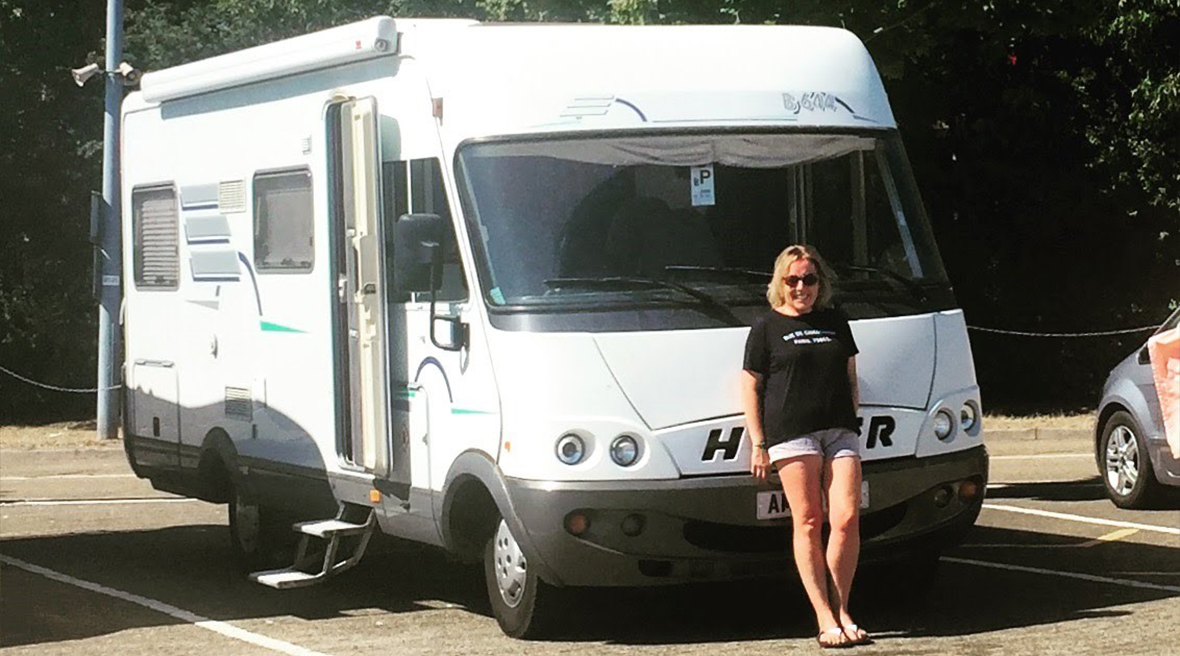
Waiting to board LeShuttle at the start of a four-week trip to Northern France
Options for overnight stops
As you explore France in your motorhome, you’ll have quite a few options of where to stay on route. Here is my list; we’ve definitely used the first three the most, and dabbled with the others.
- Aires – full title is ‘aire de service/stationnement pour camping car’ but most people call them aires for short. These motorhome stopover parking areas are in towns and villages all over France and mustn’t be confused with motorway ‘aires’ which are basically just service stations. They differ in price (from free to 20 Euros per night) and facilities vary too – from what is essentially just a car park, to a site with showers, loos, electricity, boules pistes, swimming pools, bread vans and more. The general rule is that you can stay for a max of 48 hours.
- Municipal campsites – these are not privately owned. You can get a list of nearby ones from a tourist office. They are often smaller, cheaper, less touristy and more French than bigger, homogenous ones, and are often well-placed on the edges of towns. They have fewer facilities than the mega-slide resort-style campsites.
- Private campsites – more expensive in general than the previous two but often with more facilities on site. You may be able to book ahead online or by phone (but that is limited to longer stays in high season). Prices rise with quality and quantity of facilities and proximity to tourist areas.
- France Passion – a club that gives you access to vineyards, farms and growers’ land for stopovers. Pull up and park for a night for no charge (no facilities), and perhaps take a tour with the owner or indulge in a dégustation or two. We got kidnapped by a Champagne maker once – we left the kids in the van while he gave us a two-hour tour of his cave and ‘forced’ us to try numerous vintages! We rolled back in at midnight much to the kids’ horror.
- Wild camping – this is a legal grey area in France but tolerated in non-touristy areas as long as you act responsibly.
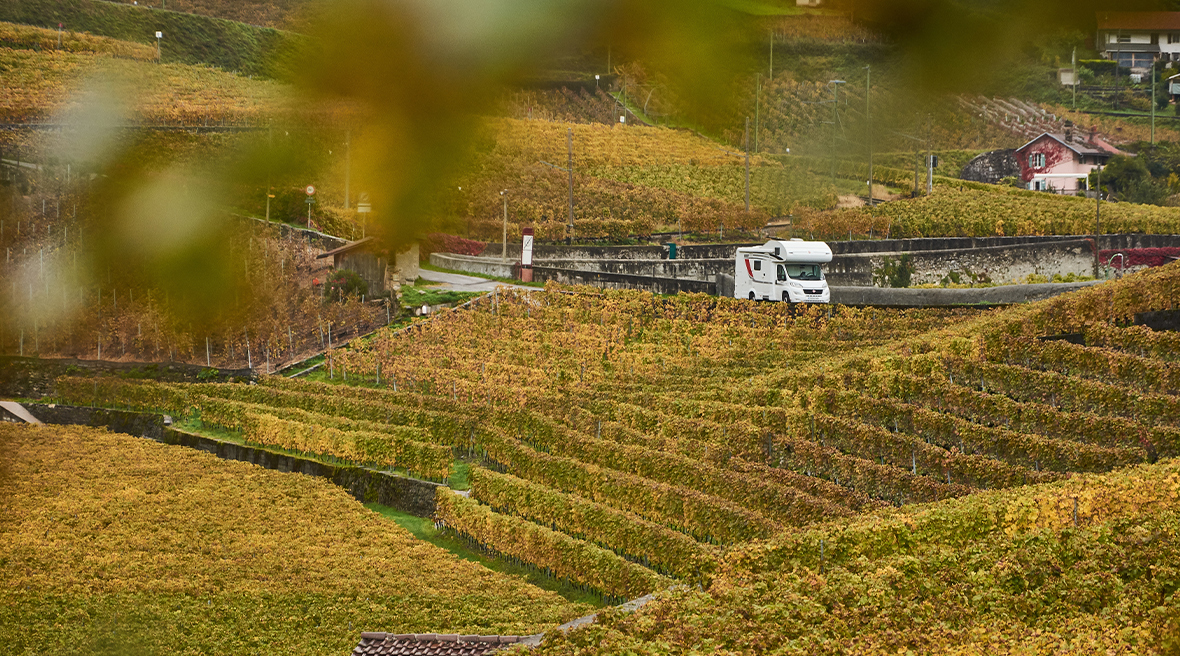
You can park up overnight in vineyards with the owners’ permission – or if you join the France Passion club
Jargon
- Euro Relais – one of the most common service point brands in France. It will include drinking water, a drain for your grey (waste) water, and facilities for emptying your toilet cassette and electricity sometimes
- Flot Bleu – another brand of service point, like Euro Relais
- Jéton – a token, a good term to know for barriers, elec points, services, washing machine
- Eau potable – drinking water
- Vidange eau noire – waste water
- Hardstanding – a pitch or space to park which is made of gravel or concrete (not grass)
- Emplacement – the French word for a camping pitch
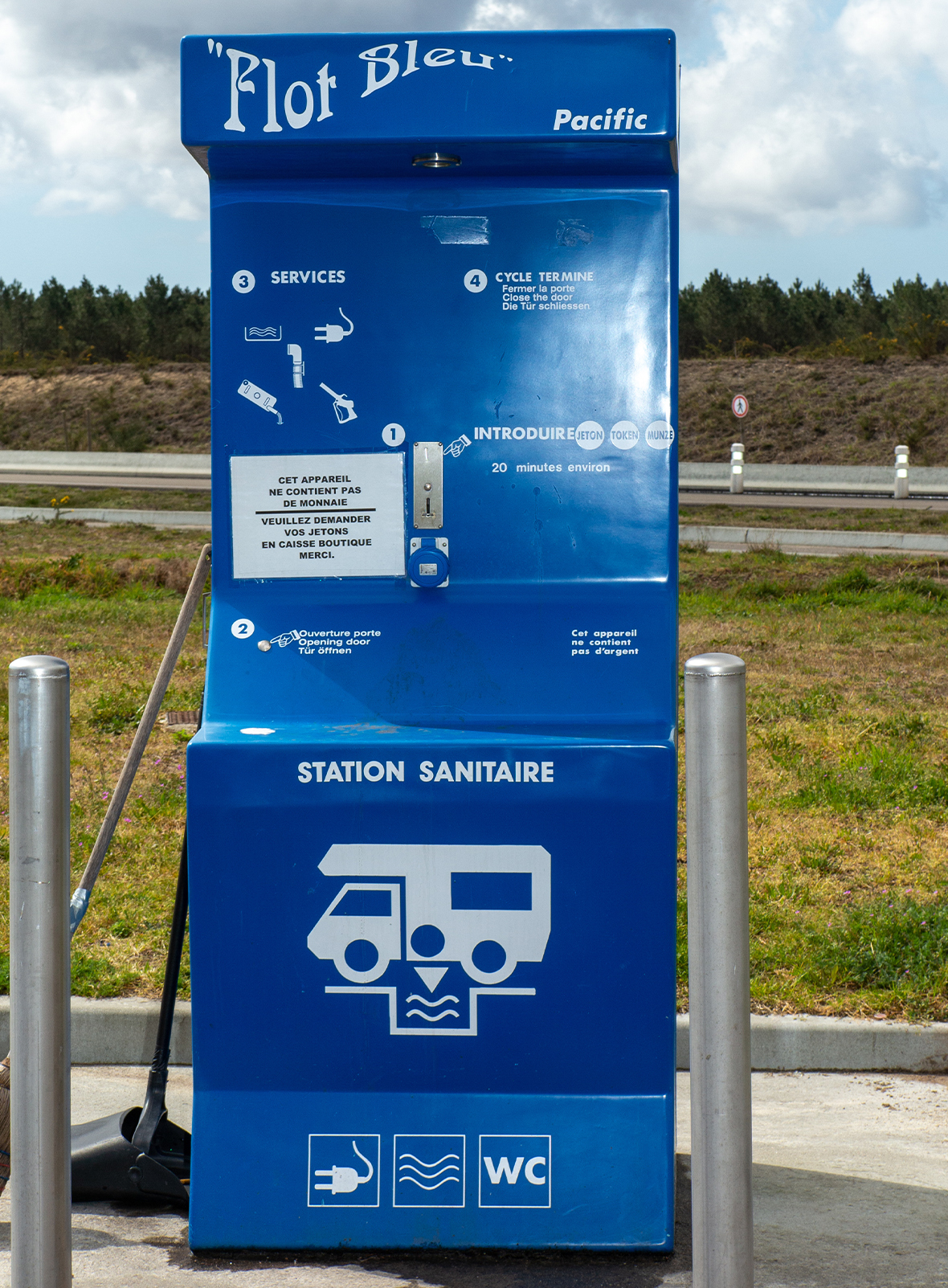
The Flot Bleu machine is seen all over France at motorhome service points
What should you pack for a motorhome holiday in France?
- A guide to aires – it’s definitely worth buying the most up-to-date edition of All The Aires from Vicarious Publishing. It’s now split into two books – North and South – or you can buy a bundle and get both.
- Long hose – buy the longest hose you can for your drinking water because sometimes you have to park a fair way from the tap and otherwise you’ll end up doing 25 trips with a watering can. Be forensic about keeping it clean and away from any waste water at the service points.
- Long electricity cable – again, as long as possible. There may be a pitch available but is it right by a hook-up? Probably not!
- Watering can – when all else fails you can top up your drinking water with a can
- Levelling blocks – Used so frequently on sloping pitches. Stick a spirit level to the dashboard too. Simple and effective.
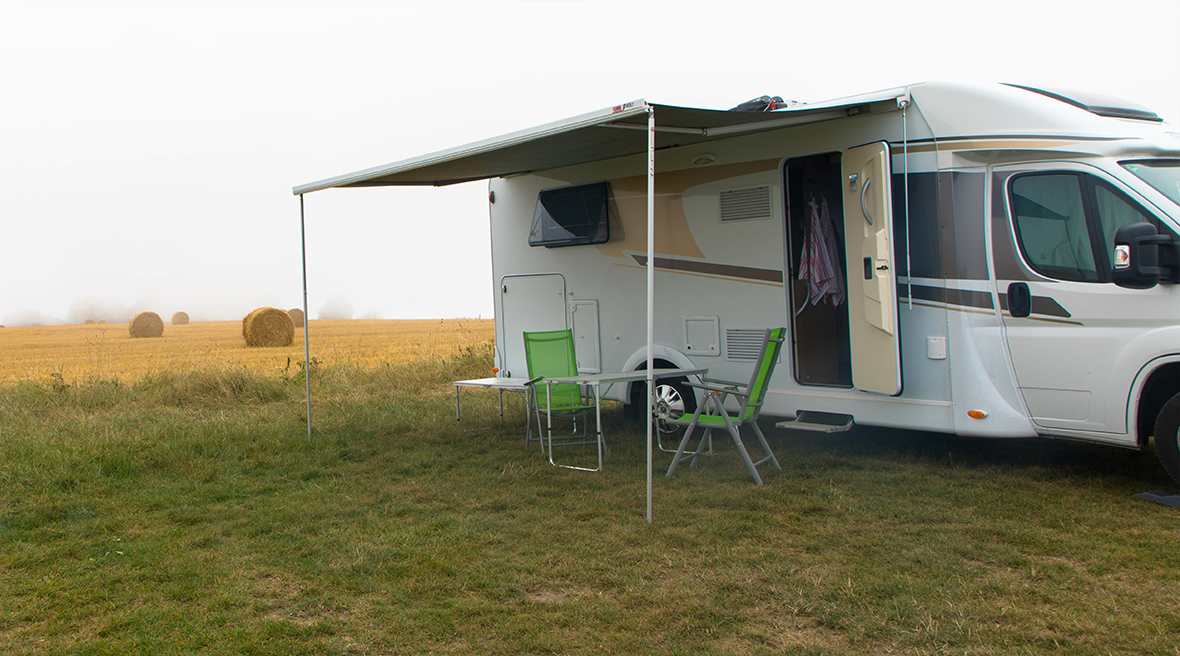
Some overnight stops offer urban access and some have open space as far as the eye can see
Planning your route
Motorhome tours are all about freedom, so you can plan as much or as little as you like. Some people like to go where the wind blows, taking into account how they feel that morning while others prefer to map out a full motorhome route through France from the beginning to the end of their trip.
Our approach has always been somewhere in the middle. We have a vague route in mind, with some fixed/anchor dates here and there so that we have enough time in each area.
- In high season, very few campsites will allow you to book ahead for a small number of nights but as long as you turn up by early afternoon, you’ll usually find a spot. There’s a lot of touring motorhome travel in France so spots usually free up on all but the most popular campsites.
- The same approach applies to aires, although here it can pay off to arrive earlier. Some early birds are up and off at 8am, while others like us tend to leave mid to late morning, freeing up spaces for newcomers.
- Aires are a lot of fun but we find that mixing them up with campsites here and there, for a dip in the pool in the summer and somewhere where you can set up a bit of an encampment, is a good approach.
- I suggest limiting the number of single night stopovers you plan in a row. A night in an aire in an interesting town or beautiful spot is a joy, but too many can mean too much driving.
- Mark your guide or keep a notebook with details of the aires and campsites you love, for future visits. It’s amazing how often you’ll pass through the same areas and think, where shall we sleep tonight?
- Get a sat nav or motorhome route planner on your phone where you can input the dimensions and weight of your motorhome - that way you’ll avoid low bridges, and tunnels and narrow lanes as you travel around. This really takes the stress out of things!
- The best time of year to go is any time you want. Late July and August are high season and busy – but this is when we go owing to children, and it’s never so busy that it’s not fun. Outside those times, France is your oyster, with quieter aires and campsites – and cheaper campsite rates!
- Even if you’re not a keen cyclist, be sure to pop a bike each on the back of your motorhome or in the storage garage. You’ll soon wonder how you ever got by without them. They’re perfect for cruising down to the boulangerie in the morning, exploring the countryside, getting into the middle of cities from aires on the outskirts and much more. France is blessed with cycle lanes galore, so it’s a much safer option than in the UK.
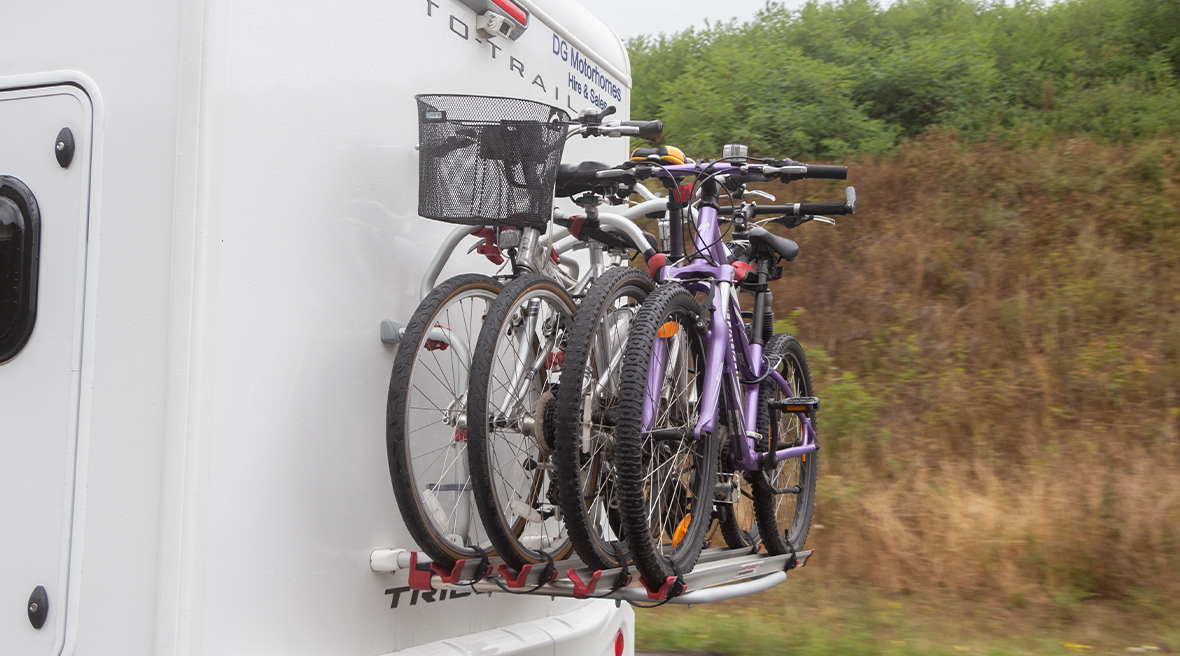
Having a four-bike bike rack was a must for our motorhome trips around France
Start your motorhoming holiday in France with LeShuttle
LeShuttle takes just 35 minutes to deliver you and your motorhome from Folkestone to Calais. That’s just enough time for coffee and a biscuit but make sure you boil the kettle before you embark, as your gas needs to be turned off! From there, France is your oyster. Head south for the sun, west for the beaches or take a trip into undiscovered heartlands.